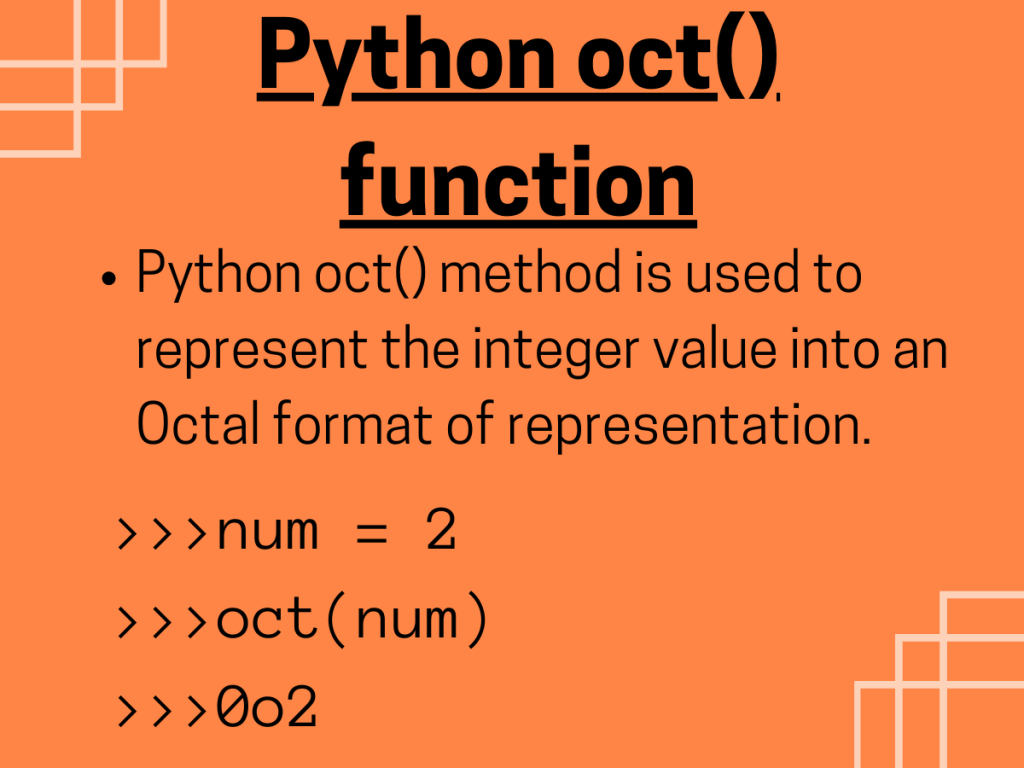Hey, folks! In this article, we will be focusing on the Octal representation of an integer value using Python oct() function.
Getting started with Python oct() function
Python has various in-built functions to manipulate and operate over data values. Python oct() method is used to represent the integer value into an Octal format of representation.
Syntax:
oct(number)
number: The integer value that has to be passed to the function. It can be a decimal, binary or hexadecimal value.
Example:
dec_num = 2
print("Octal representation of decimal number:", oct(dec_num))
bin_num = 0b10
print("Octal representation of binary number:", oct(bin_num))
hex_num = 0x17
print("Octal representation of decimal number:", oct(hex_num))
Output:
Octal representation of decimal number: 0o2
Octal representation of binary number: 0o2
Octal representation of decimal number: 0o27
Errors and Exceptions with Python oct() function
If a float type value is passed to Python oct() function, it raises a TypeError exception i.e. oct() function accepts only integer values as parameter.
Example:
dec_num = 2.4
print("Octal representation of decimal number:", oct(dec_num))
Output:
TypeError Traceback (most recent call last)
<ipython-input-3-75c901e342e0> in <module>
1 dec_num = 2.4
----> 2 print("Octal representation of decimal number:", oct(dec_num))
TypeError: 'float' object cannot be interpreted as an integer
Octal representation of elements of an array in NumPy module
The elements contained in a data structure such as NumPy arrays, lists, etc can be converted to its Octal forming using the built-in function of NumPy.
The numpy.base_repr() function is used to convert every element of the array to octal form in an element wise fashion.
Syntax:
numpy.base_repr(number, base, padding)
number: The element of the array whose octal format has to represented.base: The value which represents the resultant number system of the value to be converted. For octal representation, we need to place base = 8.padding: The number of zeros to be added to the left axis of the resultant number.
Example:
import numpy as N
arr = [23,15,36,20]
res_arr = N.base_repr(arr[0],base = 8)
print("The Octal representation of",arr[0],":",res_arr)
Output:
The Octal representation of 23 : 27
Octal representation of data values using Pandas module
Python Pandas module is used to frame the elements in the form of DataFrames and operates over datasets. Python apply(oct) function can be used to represent the integer data values of the dataset into their Octal format.
Syntax:
DataFrame.apply(oct)
Example:
import pandas as pd
dec_data=pd.DataFrame({ 'Decimal-values':[20,32,7,23] })
oct_data=dec_data['Decimal-values'].apply(oct)
print(oct_data)
Output:
0 0o24
1 0o40
2 0o7
3 0o27
Name: Decimal-values, dtype: object
Conclusion
Thus, in this article, we have understood the way of representing the integer values into their Octal format using Python oct() function.
References
- Python oct() function — JournalDev
